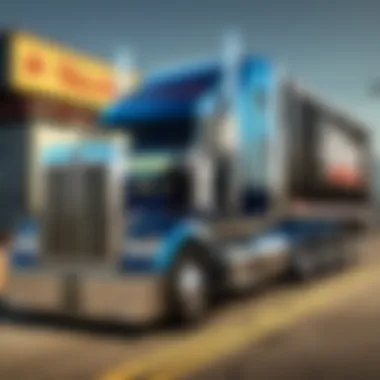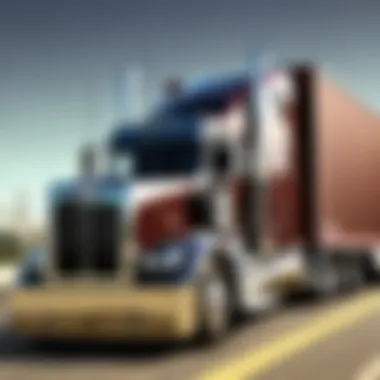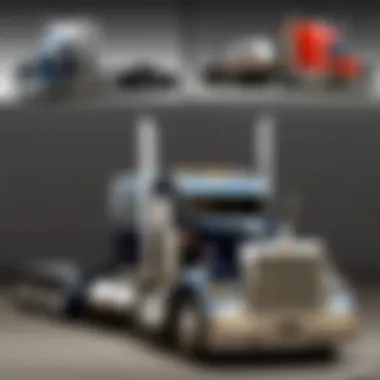Understanding 18 Wheeler Car Transporters and Their Impact


Intro
In today's logistics landscape, the role of 18-wheeler car transporters is pivotal. Their design and operational mechanisms encapsulate a complex yet fascinating aspect of automotive logistics. These massive vehicles carry vehicles from manufacturers to dealerships, aiding in the efficient distribution of cars, trucks, and SUVs.
This article aims to deconstruct these transporters, providing valuable insights into their mechanics, types, regulations, and economic impacts. As the automotive industry continues to evolve, understanding the essentials of 18-wheeler car transporters becomes crucial for enthusiasts and professionals alike.
Design Considerations
The design of 18-wheeler car transporters is a blend of engineering precision and functional requirements. These rigs must safely accommodate multiple vehicles while maintaining structural integrity. Most commonly, they come in two configurations: open trailers and enclosed trailers. The open trailers facilitate easier loading and unloading but expose vehicles to environmental factors. Meanwhile, enclosed trailers offer protection from elements but are typically costlier.
Importance of Safety and Compliance
Safety plays a vital role in the design of these transporters. Manufacturers must comply with various regulatory standards set forth by agencies like the Federal Motor Carrier Safety Administration. This includes maintaining the correct weight distribution to prevent accidents and ensuring secure loading mechanisms to safeguard vehicles en route.
Operational Mechanisms
Each 18-wheeler car transporter operates with several interconnected mechanisms. These include the tractor, which powers the trailer, and various loading systems for vehicles.
Some common operational features include:
- Hydraulic ramps for smooth vehicle loading.
- Winches to secure vehicles during transport.
- Load distribution systems to keep the trailer balanced.
Utilizing advanced ** logistics software** can enhance tracking and routing efficiencies, ensuring optimal delivery schedules.
Economic Implications
The usage of 18-wheeler car transporters is not merely a detail of logistics; it encompasses critical economic aspects. These transporters enable auto manufacturers to reduce shipping costs and timeframes significantly. This efficiency can significantly affect pricing strategies and overall market competitiveness.
Furthermore, the seasonal demand for new vehicles often necessitates the use of these transporters to meet customer expectations, leading to an uptick in freight activity and associated revenues for logistics companies.
Finally, experts predict an increasing demand for eco-friendliness in these vehicles, promoting the evolution of electric 18-wheelers in hopes to minimize environmental impacts.
Ending
This examination has sought to elucidate the essential components and functions of 18-wheeler car transporters. From the architecture of their manifests to their operational systems and prospective economic benefits, there exists a rich tapestry of information noteworthy for both professionals in logistics and automotive enthusiasts. In an arena where functionality must meet efficiency, understanding these mechanisms opens pathways to improved practices and electronic innovation within automotive transport and logistics.
Key insight: The future of 18-wheeler car transporters will likely focus on sustainable practices, enhancing both their design and operational mechanisms to align with evolving environmental standards.
Relevant resources:
Prologue to Wheeler Car Transporters
The significance of 18 wheeler car transporters in automotive logistics cannot be overstated. They serve as a critical link between manufacturers, dealerships, and consumers. These specialized vehicles are engineered to transport multiple vehicles, optimizing the process of moving cars from one point to another. The design and efficiency of these transporters reduce shipping times and enhance the overall effectiveness of logistics operations.
Additionally, 18 wheeler car transporters have evolved with industry demands. Their ability to carry different models and styles of vehicles reflects modern consumer needs and market trends. This dynamic role highlights the intertwining of transporters with the automotive sector, warranting a comprehensive understanding of their operation.
Definition and Purpose
18 wheeler car transporters are articulated trucks designed specifically to transport automobiles. They typically utilize a traile with a load capacity allowing them to carry up to eight vehicles depending on their design. The main purpose of these transporters is to facilitate efficient vehicle distribution throughout a supply chain—from the showroom floor to the residence of the consumer.
Notably, these trucks enhance the efficiency of the logistics process, cutting down on the need for multiple trips, and lowering transportation costs. Additionally, their functionality is bolstered by features that ensure the vehicles remain secure during transit, protecting both the items and the investment.
Historical Development
The evolution of 18 wheeler car transporters stems from the increasing demand for efficient vehicle transport as the automobile industry flourished. In the early 20th century, car transport was tackled using flatbed trucks. As manufacturing capabilities ramped up, the emergence of dedicated trailers specifically designed for this purpose transformed the industry landscape.
By the latter half of the century, regulated manufacturing and transportation made way for innovative designs that improved efficiency. Multi-level transporters became commonplace, allowing the transportation of a higher number of vehicles per trip. This progression influenced both regulatory frameworks and industry practices, ensuring that 18 wheeler car transporters remain vital throughout the logistics chain.
Through understanding the history, we better appreciate how necessity drives innovation within this sector, and how today’s transportation methods are often rooted in these foundational advancements.


Types of Wheeler Car Transporters
The tapestry of automotive logistics is woven with a range of essential transporters, each servicing unique needs in car transport situations. Understanding the different types of 18 wheeler car transporters is vital for anyone engaged in or considering the logistics sector. Knowing the strengths and limitations of each type can inform decisions, optimize safety, and improve efficiency in operations.
Open Transporters
Open transporters are the most common type for vehicle movement. They typically feature slotted structures that allow vehicles to be loaded directly onto the transporter without the need for enclosure. The benefits include:
- Cost Efficiency: Open transporters are generally cheaper to operate than enclosed types due, in part, to the lower design complexity.
- Ease of Access: The absence of walls or covering makes loading and unloading simpler and faster.
- Visibility: Vehicles positioned within open transporters maintain visibility, which is often necessary for inspections.
However, a major consideration includes exposure to environmental elements. Rain, snow, and debris can impact the transported vehicles. Transporters also have weight limitations, therefore it’s crucial to calculate accordingly when planning shoots of multiple vehicles.
Enclosed Transporters
In contrast to their open counterparts, enclosed transporters fully shield the vehicles from the external environment. They consist of a sturdy framework covered with panels that provide added protection. Here are some considerations for choosing enclosed transporters:
- Protection from Elements: Enclosed transporters protect valuable vehicles from weather and debris, which enhances the integrity during transit.
- Security: High-value vehicles, such as luxury cars or antiques, benefit from the heightened security during transport.
- Ventilation: These transporters also incorporate ventilation systems, ensuring that even enclosed vehicles have adequate airflow, which helps in preserving car conditions over longer distances.
Despite these significant advantages, enclosed transporters can be more expensive and may have limited loading capacity. Each logistic provider must weigh these charges against their project aims as it may drastically affect final delivery output.
Multi-Level Systems
Multi-level systems combine the aspects of open transportation with the benefits of maximizing space. These transporters can accommodate several vehicles stacked at different heights. Operative advantages include:
- Space Optimization: By utilizing vertical space, they efficiently carry more vehicles per trip, which is cost effective.
- Accessibility of Vehicles: Well-designed systems can allow easier access to each vehicle stacked on various levels, enhancing the loading and unloading process with just a tool set.
Challenges include potential risks during loading, as navigating through multiple levels often requires skilled operators. Safety concerns particularly prevail if vehicles are not secured correctly. Thourough training and awareness are crucial in ensuring safe handling.
Unique aspects of different types of 18 wheeler car transporters help shape strategically smart logistics planning for car transport purposes and can climatically define the success levels experienced.
In summation, the type of 18 wheeler car transporter selected plays a critical role in operational efficiency and vehicle preservation. Each design has its context where it excels, guiding users to make the most informed and strategic choices for their transportation needs.
Components of Wheeler Car Transporters
The components of 18 wheeler car transporters are crucial to their functionality and efficiency. Understanding these elements helps to appreciate the engineering and design needed to transport vehicles safely across various distances. Each component plays a distinct role in ensuring the safe handling of automobiles during transport. Not only does this enhance operational efficiency, but it also improves safety measures and cost management for logistics companies.
Chassis and Frame
The chassis and frame are the backbone of an 18 wheeler car transporter. They are designed to support the load and maintain stability while on the road. The chassis structure must withstand various stresses encountered during transportation, including heavy loads, road conditions, and driving maneuvers.
There are several key considerations regarding the chassis and frame:
- Material Construction: Typically made of steel or aluminum, they provide durability and weight management. High strength materials optimize load-bearing capabilities while reducing total vehicle weight.
- Design Diversity: Different designs cater to specific transport needs. For instance, a flatbed chassis offers easy access for loading and unloading vehicles.
- Engineered for Balance: The design focuses on weight distribution to prevent tipping or swaying during transit. This balance is essential for safe and effective transport operations.
Loading Systems
Loading systems represent another essential aspect of 18 wheeler car transporters. These systems determine how vehicles are loaded and unloaded, directly affecting operational efficiency and vehicle safety.
Important elements in loading systems include:
- Hydraulic Lift Ramps: Some transporters use hydraulic systems for effortless loading and unloading of vehicles. This is crucial for heavy or awkwardly shaped vehicles.
- Mechanical Rollers: Rollers assist in guiding vehicles onto the transporter. They minimize potential damage during the process, maintaining vehicle condition prior to delivery.
- Automation Features: Increasingly, technology drives development in loading systems. Automated systems can simplify processes and reduce labor costs.
Safety Features
Safety features are paramount in the design of 18 wheeler car transporters. High transportation stakes necessitate measures that ensure vehice protection and driver safety.
Key safety features include:
- Tie Down Systems: These secure vehicles during transit, preventing movement that may cause damage.
- Cameras and Sensors: Technologies that provide visual assistance during loading and generating real-time feedback help drive safety standards higher.
- Reflective and Light Technology: These installations enhance visibility on the roads, putting safety first especially during night transportation.
“The importance of adequately designed components cannot be overstated, as they contribute directly to the safe and efficient transport of vehicles across long distances.”


The above details illustrate that each component is intertwined with the performance and efficiency of car transporters. A thorough comprehension of these elements allows companies to optimize their transport schedules and reduce overhead. Planning for safety and functionality ensures that the transport operation meets the demands of modern automotive logistics.
Operating Mechanics
Operating mechanics are essential to grasping how 18 wheeler car transporters function in the automotive logistics sector. Understanding how these vehicles handle loading and unloading, transportation, and route planning contributes to enhanced efficiency and safety. This section examines these key elements in detail, illustrating their benefits and considerations whilst optimizing the performance of transporters.
Loading and Unloading Procedures
The process of loading and unloading vehicles on 18 wheeler car transporters must be efficient and safe. Car transporters often use ramp systems to allow cars to move to and from the transport equipment seamlessly. The loading procedure resources maintain organization which ensures that the transported vehicles do not become damaged during operation. This often involves the following:
- Inspection: A thorough vehicle inspection is crucial before loading. This helps in identifying any possible damages. Correct recording minimizes disputes later.
- Use of Equipment: Depending on the type of transporter, lift gates or hydraulic loading systems might be utilized to assist in moving vehicles.
- Securing Vehicles: It is imperative to properly secure the vehicles for transport to avoid any damages during transit. Safety straps or wheel chocks are standard solutions for achieving this.
- Unloading Protocol: After arrival, it is equally important to reverse the loading procedure. A safe, reverse system assists in minimizing risks, leading to thorough inspections of the vehicles as they dismount.
Transporting Techniques
The act of transporting vehicles involves several techniques designed to ensure safety and efficiency. The approach usually hinges on factors like the terrain type and the vehicle models being carried. Among the critical methods are:
- Weight Distribution: It is vital to evenly distribute the weight of the car load across the transporter. This provides stability during transport and helps to minimize the risk of tipping.
- Driving Patterns: Operators should adopt driving patterns that cater to the vehicle's dynamics. Sudden stops or sharp turns can lead to trailer instability.
- Adjusting Strategies for Enclosed vs Open Transport: The driving methods will vary according to the type of transporter. Open transporters often require more caution during inclement weather, while enclosed transporters are less vulnerable.
Each technique requires practical knowledge and often specific training to execute properly.
Route Planning
Effective route planning is a crucial aspect that impacts every bit of the transporting process. Routes are determined based on multiple logistical considerations:
- Traffic Patterns: Analyzing traffic and continually adjusting schedules prevents delays.
- Road Conditions: Knowledge of road conditions is another factor affecting route choice. Given weight and height limitations of 18 wheeler transporters, knowing which roads are passable is vital.
- Stops Along the Way: Mapping out refueling stations and rest areas is central to maintaining compliance potentially and ensuring safety.
Ultimately, insightful route planning resonates across the life cycle of car transportation, and can increase fuel efficiency and ensure timely delivery while decreasing costs.
Training staff on these foundational operational cross-sections within the industry enhances understanding, boosts safety and ultimately aids in improving the overall quality of services rendered in car transportation.
Regulatory Considerations
Regulatory considerations are critical when discussing 18 wheeler car transporters. Compliance with regulations ensures the safe and efficient operation of these vehicles. Proper regulation minimizes risks, protects the environment, and standardizes practices across the industry.
Understanding the relevant regulations can provide significant operational benefits. Companies that comply with federal and state guidelines benefit from smoother operations. Awareness of the consequences of non-compliance, such as fines or business shutdowns, is pertinent for usiness owners. This knowledge helps companies establish better relationships with local law enforcement and regulatory agencies.
Adhering to relevant regulations also fosters a better image of your company in the eyes of consumers.
Federal Regulations
Federal regulations govern the operation of commercial vehicles, including 18 wheeler car transporters. The Federal Motor Carrier Safety Administration (FMCSA) establishes rules to protect the public and the drivers. These rules encompass aspects such as weight limits, driver qualifications, and hours of service. Non-compliance risks accidents, hefty fines, or even criminal charges.
It’s essential for companies to monitor and ensure compliance. Routine training and regular audits can help maintain adherence to the rules. By integrating federal regulations into operation strategies, companies can ensure alignment with national safety standards.
State-Specific Guidelines
Each state in the USA imposes its own regulations regarding the transportation of vehicles. State-specific guidelines may include weight regulations, specific routes that must be followed, and time-of-day restrictions. Understanding local rules can streamline operations and limit unnecessary disruptions.
Companies engaging in cross-state transportation must be particularly cognizant of these differences. Keeping a comprehensive database of state guidelines is crucial for effective route planning and maintaining compliance. Moreover, it helps avoid legal issues stemming from ignorance of local laws.
Permitting Requirements
Depending on the size and type of vehicles being transported, various permits may be required. Jurisdictions often impose special permit requirements for oversized or overweight vehicles. The process of obtaining these permits can be intricate, often involving both state and local authorities.
These permits assure that carriers have the legal right to transport vehicles along designated routes. Delay due to permitting issues can impact schedules, making timely adherence all the more crucial.
To avoid interruptions, proactive planning in permit acquisition is vital. Maintaining communication with relevant authorities can also help facilitate smoother transport operations. Companies must ensure all necessary documents are in order prior to embarking on transport missions.
Economic Impact of Wheeler Car Transporters
The economic impact of 18 wheeler car transporters touches various aspects of the automotive logistics industry. The reliance on these transporters is a central feature of vehicular distribution networks, facilitating the movement of not just cars, but also contributing to broader economic activities. Understanding the economic dynamics is imperative for stakeholders in logistics, transportation, and the automotive sector.


Cost Analysis
Cost analysis serves as a foundational element in evaluating the overall impact of 18 wheeler car transporters. In this context, several factors come into play:
- Initial Investment: Acquiring a transport vehicle often involves significant upfront costs, including purchase price, maintenance, and insurance.
- Operational Costs: Fuel, labor, and routine maintenance dictate the continuous expenses. Fuel price fluctuations can create substantial uncertainties, impacting profitability.
- Return on Investment: It is crucial to assess how efficiently these costs align with delivered value. Profit margins can vary, influenced by contract types and distance travelled.
Conducting a thorough cost analysis is essential to Graham making informed decisions within budget constraints. Understanding both direct and indirect costs enables transport companies to strategise better for higher profitability.
Market Demand
The market demand for 18 wheeler car transporters is directly linked to growth in the automotive industry. Fundamental factors that drive this demand include:
- E-commerce Growth: While a lot of retail is moving online, the requirements for car transportation increases in tandem, needing robust infrastructure for efficient deliveries.
- Regional Preferences: The approach of different dealerships and consumers in various regions shapes demand. Some areas promote light vehicles, while others lean towards trucks or SUVs, driving the type of transport services.
- Supply Chain Optimization: As businesses optimize their processes for efficiency, reliable transport becomes essential. The responsiveness in logistics can significantly affect consumer satisfaction and procurement cycles.
Evaluating market demand is a useful way to scrutinize the adaptability of 18 wheeler car transporters to economic shifts in the automotive marketplace.
Industry Growth Trends
Understanding industry growth trends is vital for predicting the future of 18 wheeler car transporters. Unfortunately, certain factors can cause industry fluctuations, impacting growth:
- Technological Advances: Automation and other innovations can reshape transportation dynamics, presenting opportunities for efficiency and cost-saving.
- Economic Climate: National and global economic conditions will directly affect demand. A robust economy often means that manufacturers and dealerships are looking to move bigger volumes, translating into higher needs for transport services.
- Environmental Regulations: As regulations become increasingly stringent regarding emissions and fuel use, adapting to these demands influences maintenance and operating costs. Transporters that meet these standards may benefit from incentives or subsidies.
Sector stakeholders should monitor these trends closely to address evolving greater logistics challenges assaulted by market demands and regulatory pressures. Maintaining the flexibility to adopt adjustments is crucial in an ever-changing vehicle transporting landscape.
The role of 18 wheeler car transporters fundamentally governs not only logistical operations but also shapes competitive advantage within the increasingly global marketplace.
Future of Car Transporting Industry
The future of car transporting industry is a crucial aspect when examining 18 wheeler car transporters. این مازو them, because they play a vital role in the logistics of vehicle transportation. Future developments can greatly influence the efficiency, safety, and environmental impact of this industry. [1]
Technological Innovations
Technological advancements are reshaping the car transportation landscape. Many companies are investing in new technologies to improve how vehicles are transported.
- Automation: Automated systems are becoming mainstream. Robotics for loading and unloading help to reduce human error.
- Telematics: Vehicle tracking through GPS allows for improved route planning. Fleet management tools provide data to enhance operational performance.
- Electric Vehicles: The rise of electric trucks is changing transport dynamics. They can lower carbon footprint, reducing environmental impact in logistics. This adaption highlights the industry's pilots network durabilities.
Many transporters transition to more sustainable choices, aligning fir goals with environmental standards.
These technological innovations are not only improving operational processes. They also drive down costs and offer clients greater transparency in their transportation logistics. A well-connected transporter can provide accurate delivery times, streamline processes, and increase overall satisfaction.
Sustainability Initiatives
With growing concerns about the environment, sustainability initiates are increasingly critical for the car transporting industry. Measures to prioritize sustainable practices involve adjusting operations to reduce waste and energy consumption. Some key initiatives include:
- Alternative Fuel Sources: Companies explore biodiesel and hydrogen as alternatives to traditional diesel fuels. These solutions can complete with legal requirements while addressing ecological concerns.
- Route Optimization: Adjusting of methods to find optimal paths helps reduce fuel usage. Integration of software reduces total miles driven.
- Training Programs: Drivers and operators receive ongoing education about efficient driving practices. Proper instruction on vehicle usage leads to reduced emissions.
By embracing sustainability initiatives, the car transportation industry can prepare for regulations likely to emerge in the near future. कार ब्रोम justueel Ineffective models tread into threat zones as changes push for greener practices.
Global Perspectives
The global market dynamics present an expansive view of the future of car transporters. Economic patterns differ across regions. Analyzing these regional characteristics provides insight into industry direction. Topics to note include:
- Emerging Markets: Increasing vehicle production in countries like India and China puts pressure for transporting capabilities across borders. This demands flexible transport methods in faster routes in all national lines revenue returns.
- Trade Policies: Strict economic guidelines imposed by different countries guide transporters regarding what can be exported, requiring them understand the complexities across various continents.
- Cultural Differences: Managing cross-border logistics can present challenges. Understanding different regulations is integral to international operations.
Monitoring these global trends, car transport firms will adapt and innovate. זה sujeto to continuous change as motors continue in vernacular exploration.
In summary, the future of car transportation industry is framed collaboratively through technological advancements, sustainable initiatives, and a global outlook that pave the way for more effective vehicle transporting practices.
Epilogue
The importance of understanding 18 wheeler car transporters cannot be overstated, especially considering their significant role in the automotive logistics sector. These transporters facilitate the movement of vehicles across long distances efficiently. A well-structured knowledge of their mechanics leads to improved operation and enhanced logistics planning.
The economic impact of 18 wheeler car transporters is profound. They not only provide cost-effective solutions but also contribute to market demand. Furthermore, various regulatory frameworks affect their operations. This necessitates a clear comprehension of existing guidelines and the ability to adapt to changes.
In summarising this article, we have explored key aspects such as types of transporters, components, and the operating mechanics involved. It sheds light on their essential features and the need for operating efficiencies.
In light of future advancements in structural design and technology adaptation, one must consider the increasing importance of sustainability in operations.



